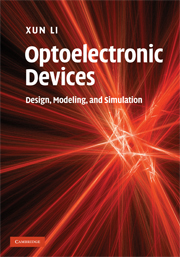Book contents
- Frontmatter
- Contents
- Preface
- 1 Introduction
- 2 Optical models
- 3 Material model I: Semiconductor band structures
- 4 Material model II: Optical gain
- 5 Carrier transport and thermal diffusion models
- 6 Solution techniques for optical equations
- 7 Solution techniques for material gain equations
- 8 Solution techniques for carrier transport and thermal diffusion equations
- 9 Numerical analysis of device performance
- 10 Design and modeling examples of semiconductor laser diodes
- 11 Design and modeling examples of other solitary optoelectronic devices
- 12 Design and modeling examples of integrated optoelectronic devices
- Appendices
- Index
10 - Design and modeling examples of semiconductor laser diodes
Published online by Cambridge University Press: 09 October 2009
- Frontmatter
- Contents
- Preface
- 1 Introduction
- 2 Optical models
- 3 Material model I: Semiconductor band structures
- 4 Material model II: Optical gain
- 5 Carrier transport and thermal diffusion models
- 6 Solution techniques for optical equations
- 7 Solution techniques for material gain equations
- 8 Solution techniques for carrier transport and thermal diffusion equations
- 9 Numerical analysis of device performance
- 10 Design and modeling examples of semiconductor laser diodes
- 11 Design and modeling examples of other solitary optoelectronic devices
- 12 Design and modeling examples of integrated optoelectronic devices
- Appendices
- Index
Summary
Design and modeling of the active region for optical gain
The active region material
Specification of the lasing wavelength and substrate material availability usually dictate the active region material selection. However, in some wavelength bands, the selection of the material is not unique. For example, either one of the following systems: InGaAsP on InP substrate, InAlGaAs on InP substrate, InGaAsN on GaAs substrate, and InAsPN on GaAs substrate, can be chosen as the active region material for semiconductor laser diodes emitting in the 1300 nm band. In this section, however, we will compare only the first two systems, which seem to be more mature in production. Table 10.1 summarizes the features of the two active region structures made of the two different material systems.
Unlike the InGaAsP/InP heterojunction with a smaller conduction band offset (∼36%) compared to the valence band offset (∼64%), the InAlGaAs system has a larger offset (∼71%) on the conduction band side. As such, the InAlGaAs system has a better confining effect on the injected electrons. Hence it has better temperature characteristics as a result of the effective reduction of electron current leakage, which is the dominant form of leakage due to the high electron mobility [2].
In accordance with the active region designs in Table 10.1, the calculated transverse lectric (TE) mode material gain profiles are shown in Fig. 10.1. Since we have used the same well thickness and the same number of QWs in these two material systems, the sheet carrier density in the InAlGaAs and InGaAsP QWs is the same at each carrier injection level.
- Type
- Chapter
- Information
- Optoelectronic DevicesDesign, Modeling, and Simulation, pp. 251 - 287Publisher: Cambridge University PressPrint publication year: 2009



